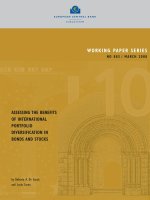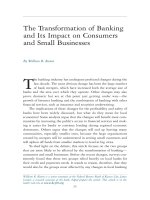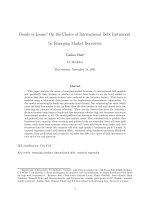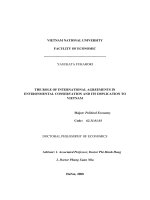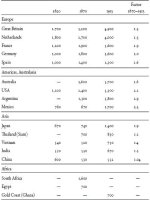Emerging economies and the transformation of international buisness brazil, russia, india and china
Bạn đang xem bản rút gọn của tài liệu. Xem và tải ngay bản đầy đủ của tài liệu tại đây (3.39 MB, 567 trang )
Emerging Economies and the Transformation
of International Business
NEW HORIZONS IN INTERNATIONAL BUSINESS
Series Editor: Peter J. Buckley
Centre for International Business,
University of Leeds (CIBUL), UK
The New Horizons in International Business series has established itself as the world’s
leading forum for the presentation of new ideas in international business research. It
offers pre-eminent contributions in the areas of multinational enterprise – including
foreign direct investment, business strategy and corporate alliances, global
competitive strategies, and entrepreneurship. In short, this series constitutes essential
reading for academics, business strategists and policy makers alike.
Titles in this series include:
Free Trade in the Americas
Economic and Political Issues for Governments and Firms
Edited by Sidney Weintraub, Alan M. Rugman and Gavin Boyd
Economic Integration and Multinational Investment Behaviour
European and East Asian Experiences
Edited by Pierre-Bruno Ruffini
Strategic Business Alliances
An Examination of the Core Dimensions
Keith W. Glaister, Rumy Husan and Peter J. Buckley
Investment Strategies in Emerging Markets
Edited by Saul Estrin and Klaus E. Meyer
Multinationals and Industrial Competitiveness
A New Agenda
John H. Dunning and Rajneesh Narula
Foreign Direct Investment
Six Country Case Studies
Edited by Yingqi Annie Wei and V.N. Balasubramanyam
Japanese Multinationals in Europe
A Comparison of the Automobile and Pharmaceutical Industries
Ken-ichi Ando
International Joint Venture Performance in South East Asia
Craig C. Julian
Governance, Multinationals and Growth
Edited by Lorraine Eden and Wendy Dobson
European–American Trade and Financial Alliances
Edited by Gavin Boyd, Alan M. Rugman and Pier Carlo Padoan
Transformations in Global Governance
Implications for Multinationals and Other Stakeholders
Edited by Sushil Vachani
Emerging Economies and the Transformation of International Business
Brazil, Russia, India and China (BRICs)
Edited by Subhash C. Jain
Emerging Economies
and the Transformation
of International
Business
Brazil, Russia, India and China (BRICs)
Edited by
Subhash C. Jain
University of Connecticut, USA
NEW HORIZONS IN INTERNATIONAL BUSINESS
Edward Elgar
Cheltenham, UK • Northampton, MA, USA
© Subhash C. Jain 2006
All rights reserved. No part of this publication may be reproduced, stored in
a retrieval system or transmitted in any form or by any means, electronic,
mechanical or photocopying, recording, or otherwise without the prior
permission of the publisher.
Published by
Edward Elgar Publishing Limited
Glensanda House
Montpellier Parade
Cheltenham
Glos GL50 1UA
UK
Edward Elgar Publishing, Inc.
William Pratt House
9 Dewey Court
Northampton
Massachusetts 01060
USA
A catalogue record for this book
is available from the British Library
Library of Congress Cataloguing in Publication Data
Emerging economies and the transformation of international business :
Brazil, Russia, India and China / edited by Subhash C. Jain.
p. cm.
Includes bibliographical references and index.
1. International trade. 2. Strategic planning—Developing countries—Case
studies. I. Jain, Subhash C. (Subhash Chandra), 1938–
HF1379.E47 2006
338.8Ј8—dc22
2006005605
ISBN-13: 978 1 84542 597 5
ISBN-10: 1 84542 597 9
Printed and bound in Great Britain by MPG Books Ltd, Bodmin, Cornwall
A UCONN CIBER SUPPORTED RESEARCH INITIATIVE
CIBER is a program of the US Department of Education.
The CIBER program’s mandate is to enhance US competitiveness in
the global business arena through activities involving US businesses,
educators and students.
v
Contents
ix
xiii
xv
List of contributors
Foreword
Preface
PART I
INTRODUCTION
1
Dreaming with BRICs: the path to 2050
Dominic Wilson and Roopa Purushothaman
2
BRIC economies: earlier growth constraints, contemporary
transformations and future potential, and key challenges
Ben L. Kedia, Somnath Lahiri and Debmalya Mukherjee
PART II
3
46
MARKET OPPORTUNITY
3
Economic growth with the advent of international
economic law: implications for emerging economies
Linda Yueh
77
4
Global strategies of Brazilian firms in an era of economic
liberalization
Preet S. Aulakh
91
5
Corporate governance and business strategies in Russia
Igor Filatotchev
111
6
Acquisitions in BRIC economies: the case of India
Prashant Kale
138
7
Development prospects of China’s industries
Zhiwu Chen
155
PART III
STRATEGIC DIRECTION
8
International business strategies in Brazil
Robert Grosse
183
9
The tortuous trail toward corporate governance in Russia
Daniel J. McCarthy and Sheila M. Puffer
206
vii
viii
Contents
10
Strategic evolution and partnering in the Indian
pharmaceutical industry
Ravi Sarathy
229
11
Transitions in innovation: musings on the propensity and
factors towards proactive innovation in China
William H.A. Johnson
250
PART IV ENTRY ALTERNATIVES
12
The future shape of world exports to the BRIC countries
Stephen Coelen
271
13
The international joint venture performance of American
firms: a comparative analysis of emerging markets and
non-emerging markets
Hemant Merchant
294
14
Inward and outward FDI and the BRICs
Karl P. Sauvant
313
15
Negotiating in BRICs: business as usual isn’t
Camille P. Schuster
410
PART V
CHALLENGES AND OBSTACLES
16
The impact of coercion on protecting US intellectual property
rights in the BRIC economies
Robert C. Bird
431
17
Corruption in large developing economies: the case of Brazil,
Russia, India and China
Mohsin Habib and Leon Zurawicki
452
18
BRICs: geopolitical and economic challenges for the US
Subhash C. Jain
478
PART VI
19
CONCLUSION
Peaks and pits with the BRICs: accommodations
with the West
Jack N. Behrman
Index
513
537
Contributors
Preet S. Aulakh holds the Pierre Lassonde Chair in International Business
at the Schulich School of Business, York University, Canada. He has done
extensive research on various international business areas, including
foreign entry modes, managing cross-border alliances and partnerships,
structuring international distribution channels, international licensing
agreements, international strategies and performance of firms from emerging economies, among others.
Jack N. Behrman is Lurther Hodges Distinguished Professor Emeritus at
the University of North Carolina’s Kenan-Flagler Business School. His
expertise lies in the areas of international economics & business, transnational corporations (TNCs), international business–government relations, ethics, comparative management, science and technology, and
creativity and innovation.
Robert C. Bird is an Assistant Professor of Legal Studies at the University
of Connecticut. Robert received his JD and MBA from Boston University.
Robert’s research interests include employment law and intellectual property law.
Zhiwu Chen is Professor of Finance at Yale School of Management, Yale
University. He is an expert on finance theory, securities valuation, emerging
markets, and China’s economy and capital markets. In the last few years, he
has been actively doing research on market development and institutionbuilding issues in the context of China’s transition process and other emerging markets.
Stephen Coelen holds several positions: Professor in Residence in
Economics at the University of Connecticut; Research Associate in both
the Connecticut Center for Economic Analysis (CCEA) and the Center for
International Business Education and Research (CIBER); and Adjunct
Professor and chief international advisor to the University of Fort Hare in
the Republic of South Africa.
Igor Filatotchev is a Professor of International Strategic Management at
King’s College London. His research interests are focused on corporate
ix
x
Contributors
governance effects on entrepreneurship development, strategic decisions
and organizational change. He earned his PhD in Economics from the
Institute of World Economy and International Relations (Moscow) in 1985.
Robert Grosse has taught international finance in the MBA programs at the
University of Miami, University of Michigan, and Instituto de Empresa
(Madrid, Spain). He has also taught in many Latin American universities,
where he is a leading author on international business. He is currently
President of the Business Association of Latin American Studies.
Mohsin Habib is Associate Professor of Management at the University
of Massachusetts-Boston. He teaches global management and ethics at
the undergraduate and MBA levels. His research interests include the
role of corruption in international business, FDI, and country-level
competitiveness.
Subhash C. Jain is a Professor of International Marketing, Director of the
Center for International Business Education and Research (CIBER)
funded by the US Department of Education, and Director of the GE
Global Learning Center endowed by General Electric Company, in the
School of Business, University of Connecticut.
William H.A. Johnson is an Assistant Professor of Operations and
Technology in the Management Department of Bentley College in
Waltham, MA. His research is diverse and multidisciplinary, examining
issues of cooperative innovation including initiatives in subsidiary innovation, use of options thinking in strategic innovation and processes in new
product development and R&D projects.
Prashant Kale is in the faculty of Corporate Strategy and International
Business at the Stephen M. Ross School of Business, University of
Michigan. His research focuses on the role and management of strategic
alliances and acquisitions in the context of both emerging technologies and
emerging economies.
Ben L. Kedia is Robert Wang Professor of International Business at the
University of Memphis in Memphis, TN, and Director of the Memphis
CIBER. His research focuses on emerging economies, international outsourcing, and knowledge transfer among multinational corporations.
Somnath Lahiri is advanced doctoral student in Management at the
University of Memphis, TN. His research interests include emerging
economies and international outsourcing.
Contributors
xi
Daniel J. McCarthy is the Alan S. McKim and Richard A. D’Amore
Distinguished Professor of Global Management and Innovation at the
College of Business Administration, Northeastern University, Boston,
MA. He is a Fellow at the Davis Center for Russian Studies at Harvard
University, and is one of the top two scholars internationally in business
and management in Russia, based on a study of publications in leading
journals from 1986 to 2002.
Hemant Merchant is the Dean’s Endowed Research Fellow and Associate
Professor of International Strategy at Simon Fraser University
(Vancouver, Canada). He is the recipient of the 2005 and 2006 Douglas
C. Mackay Outstanding Paper Awards in International Business.
Debmalya Mukherjee is advanced doctoral student in Management at the
University of Memphis, TN. His research interests include emerging
economies and cross-border knowledge transfers.
Sheila M. Puffer is a Professor of International Business at Northeastern
University, Boston, MA. She has been recognized as the number 1 scholar
internationally in business and management in Russia based on a study of
publications in 12 leading academic journals from 1986 to 2002. She is a
Fellow at the Davis Center for Russian Studies at Harvard University.
Roopa Purushothaman is a global economist at Goldman Sachs, covering
global thematic issues as a member of the global research team.
Ravi Sarathy is a Professor of Management and International Business in
the College of Business Administration at Northeastern University. His
major interests are in international business and international marketing
and global strategy.
Karl P. Sauvant is the Executive Director of the Columbia Program on
International Investment (a joint undertaking of Columbia Law School
and the Earth Institute), Lecturer in Law at Columbia Law School, Special
Advisor to the UN Millennium Project and Guest Professor at Nankai
University, China.
Camille P. Schuster is a Professor of Marketing and International Business
at California State University San Marcos. She received her PhD from The
Ohio State University and her MA from Arizona State University.
Dominic Wilson is a senior global economist at Goldman Sachs. He works
on global thematic issues as a member of the global research team.
xii
Contributors
Linda Yueh is Fellow in Economics, Pembroke College, Oxford University,
and is also appointed to the Department of Economics, LSE. Her research
areas include globalization, the Chinese economy, and economic development and growth as well as aspects of international law and economics.
Leon Zurawicki is a Professor of International Marketing at the University
of Massachusetts-Boston. He is an author of four books and numerous
articles. Dr Zurawicki’s research interests center on corruption in international business.
Foreword
The twenty-first century may well be the time when the balance of power
shifts to Brazil, Russia, India and China, nations collectively referred to as
BRICs. These nations constitute the shape of the future, giving rise to a new
world economy. Leaders in BRICs are frenetically laying the groundwork
for decades of new growth. Predictions are that in less than 50 years, the
BRICs economies, if things go right, could be larger than those of the G6
(the United States, Japan, Germany, the UK, France and Italy).
If the BRICs meet the projections cast for them, there will be significant
implications for the US economy. As the developed nations become a
shrinking part of the global market, the evolving markets in BRICs could
provide tremendous opportunities for many US companies. Thus, it is
imperative for our companies to be invested in and involved in the BRIC
markets. This is an extremely important strategic choice for many firms.
Are we ready to face the challenges that the BRICs might pose? Perhaps
not. While the opportunities in China are well understood, I suspect the
potential in India, Russia and Brazil is not. Extensive education is needed
to make our business leaders of today and tomorrow aware of the relative
importance of BRICs as an engine of new demand growth and spending
power.
Different educational opportunities are available to US managers to
learn about global markets. The CIBER (Center for International Business
Education and Research) program of the US Department of Education is
uniquely relevant in assisting US firms to become globally aware and learn
to compete in BRICs and other emerging markets. Thirty business schools
that receive the CIBER grant organize a variety of programs geared toward
enhancing US competitiveness in global markets through undertaking educational, outreach and research programs. The BRIC Conference at the
University of Connecticut, held in spring 2005, is an example of a CIBER
program. The conference was organized by the University of Connecticut
CIBER and was co-sponsored by CIBERs at Columbia University,
University of Memphis, Thunderbird, the Galvin School of Management
and the University of Wisconsin.
The BRIC Conference highlighted the emergence of Brazil, Russia,
India and China as significant future players in the global economy. It was
an impressive gathering of scholars from all over the world presenting their
xiii
xiv
Foreword
views on the rise of BRICs and what America must do to compete with
these nations. I am glad that the conference papers have been assembled to
be issued as a book. It should be interesting and necessary for both college
students and professionals to learn about BRICs and how to cope with the
challenges that their growth generates.
I am grateful to the US Department of Education, especially Program
Specialist Susanna Easton, who has strongly backed our CIBER in this and
its other endeavors. Her gifted leadership has gone a long way in promoting internationalization of business schools throughout the country.
I want to commend Subhash C. Jain, the Director of UCONN CIBER,
for the excellent idea of holding the BRICs Conference. He and his staff
deserve applause for the superb job of organizing the conference.
I must recognize the co-sponsoring CIBERs at Columbia, Memphis,
Thunderbird and Wisconsin that teamed up with UCONN to support the
event financially. Finally, I want to thank Subhash Jain for asking me to
write the Foreword, and wish the contributing authors success in their
future research.
William C. (Curt) Hunter, Dean
School of Business
University of Connecticut
Preface
After the collapse of the Soviet Union, the US became the lone superpower
of the world. But it may not be able to hold this dominant position for long.
The rapid transformation of BRICs means the US must prepare for a far
different future, one where it must learn to share economic power as never
before. The US must craft fresh strategies that will allow her to thrive in the
shifting economic environment. US companies must train their current and
future managers to compete with firms in the BRICs.
The BRIC Conference at the University of Connecticut in spring 2005
was held to examine what the US must do to compete with BRICs.
Nineteen scholars from the US and abroad presented papers to examine
various aspects of the ascendancy of BRICs. This book comprises the collection of these papers. The book presents what Americans need to know
now about Brazil, Russia, India and China that will transform the global
economy. It delves into the massive power of the BRICs and how they will
reshape the global economy; it examines what could occur to slow their
growth; it studies their strengths and weaknesses; and asks what the US
should do to maintain its lead in terms of both government policies and
firm strategies.
This book, which is the output of the BRIC Conference, would not be
possible without the active support of a number of individuals whom I must
recognize. First, I am grateful to all the colleagues from different parts of
the world for traveling to the University of Connecticut to participate in and
speak at the conference. Without their commitment this book would not be
feasible. Second, I want to thank CIBER Directors at Columbia University,
University of Memphis, Thunderbird, the Galvin School of Management
and the University of Wisconsin for co-sponsoring the BRICs Conference.
Third, I am indebted to Dean William C. (Curt) Hunter, University of
Connecticut, for writing the Foreword to this book despite his heavy commitments and frequent travels. Fourth, the CIBER colleagues at UCONN:
Associate Director Kelly Aceto, and Student Manager of the program Alla
Remen deserve my sincere thanks for their support in pursuing the BRIC
program. Alla worked hard to coordinate the program with the speakers,
while Kelly took care of the minutest logistical details. Along with them, I
want to convey my thanks to graduate assistant Stephen Petretto and office
staff Regina Forker and Diksha Gagrani for their wholehearted help and
xv
xvi
Preface
support. Lastly, I want to thank my wife for putting up with me working late
hours for several weeks before and during the conference. Her intellectual
and moral support keep me going.
As in the past, it has been a pleasure working with the people at Edward
Elgar Publishing. Both Acquisition Editor Alan Sturmer and Production
Editor Kate Emmins have been extremely helpful in making this book possible. I owe them a large debt of thanks.
Subhash C. Jain
1 September 2005
PART I
Introduction
1. Dreaming with BRICs: the path
to 2050
Dominic Wilson and Roopa Purushothaman
Over the next 50 years, Brazil, Russia, India and China – the BRICs
economies – could become a much larger force in the world economy. Using
the latest demographic projections and a model of capital accumulation
and productivity growth, we map out GDP growth, income per capita and
currency movements in the BRICs economies until 2050.
The results are startling. If things go right, in less than 40 years, the
BRICs economies together could be larger than the G6 in US dollar
terms. By 2025 they could account for over half the size of the G6.
Currently they are worth less than 15 percent. Of the current G6, only the
US and Japan may be among the six largest economies in US dollar terms
in 2050.
About two-thirds of the increase in US dollar GDP from the BRICs
should come from higher real growth, with the balance through currency
appreciation. The BRICs’ real exchange rates could appreciate by up to 300
percent over the next 50 years (an average of 2.5 percent a year).
The shift in GDP relative to the G6 takes place steadily over the period,
but is most dramatic in the first 30 years. Growth for the BRICs is likely to
slow significantly toward the end of the period, with only India seeing
growth rates significantly above 3 percent by 2050. And individuals in the
BRICs are still likely to be poorer on average than individuals in the G6
economies, with the exception of Russia. China’s per capita income could
be roughly what the developed economies are now (about US$30 000 per
capita).
As early as 2009, the annual increase in US dollar spending from the
BRICs could be greater than that from the G6 and more than twice as much
in dollar terms as it is now. By 2025 the annual increase in US dollar spending from the BRICs could be twice that of the G6, and four times higher
by 2050.
The key assumption underlying our projections is that the BRICs maintain policies and develop institutions that are supportive of growth. Each
of the BRICs faces significant challenges in keeping development on track.
3
4
Introduction
This means that there is a good chance that our projections are not met,
either through bad policy or bad luck. But if the BRICs come anywhere
close to meeting the projections set out here, the implications for the pattern
of growth and economic activity could be large.
The relative importance of the BRICs as an engine of new demand
growth and spending power may shift more dramatically and quickly than
expected. Higher growth in these economies could offset the impact of
graying populations and slower growth in the advanced economies.
Higher growth may lead to higher returns and increased demand for
capital. The weight of the BRICs in investment portfolios could rise sharply.
Capital flows might move further in their favour, prompting major currency
realignments.
Rising incomes may also see these economies move through the ‘sweet
spot’ of growth for different kinds of products, as local spending patterns
change. This could be an important determinant of demand and pricing
patterns for a range of commodities.
As today’s advanced economies become a shrinking part of the world
economy, the accompanying shifts in spending could provide significant
opportunities for global companies. Being invested in and involved in the
right markets – particularly the right emerging markets – may become an
increasingly important strategic choice.
The list of the world’s ten largest economies may look quite different in
2050. The largest economies in the world (by GDP) may no longer be the
richest (by income per capita), making strategic choices for firms more
complex.
DREAMING WITH BRICS
The world economy has changed a lot over the past 50 years. Over the next
50, the changes could be at least as dramatic.
We have highlighted the importance of thinking about the developing
world in our recent global research, focusing on key features of development and globalization that we think are important to investors with a
long-term perspective. A major theme of this work has been that, over the
next few decades, the growth generated by the large developing countries,
particularly the BRICs (Brazil, Russia, India and China) could become a
much larger force in the world economy than it is now – and much larger
than many investors currently expect.
In this piece, we gauge just how large a force the BRICs could become over
the next 50 years. We do this not simply by extrapolating from current growth
rates, but by setting out clear assumptions about how the process of growth
Dreaming with BRICs
5
and development works and applying a formal framework to generate longterm forecasts. We look at our BRICs projections relative to long-term projections for the G6 (the US, Japan, the UK, Germany, France and Italy).1
Using the latest demographic projections and a model of capital accumulation and productivity growth, we map out GDP growth, income per
capita and currency movements in the BRICs economies until 2050. This
allows us to paint a picture of how the world economy might change over
the decades ahead.
The results of the exercise are startling. They suggest that if things go
right, the BRICs could become a very important source of new global
spending in the not too distant future. Figure 1.1 shows that India’s
economy, for instance, could be larger than Japan’s by 2032, and China’s
larger than the US by 2041 (and larger than everyone else as early as 2016).
The BRICs economies taken together could be larger than the G6 by 2039.
Our projections are optimistic, in the sense that they assume reasonably
successful development. But they are economically sensible, internally consistent and provide a clear benchmark against which investors can set their
expectations. There is a good chance that the right conditions in one or
another economy will not fall into place and the projections will not be realized. If the BRICs pursue sound policies, however, the world we envisage
here might turn out to be a reality, not just a dream.
The projections leave us in no doubt that the progress of the BRICs will
be critical to how the world economy evolves. If these economies can fulfill
their potential for growth, they could become a dominant force in generating spending growth over the next few decades.
A DRAMATICALLY DIFFERENT WORLD
We start with some key conclusions that describe the way the world might
change by 2050. The big assumption underlying all of these projections is
that the BRICs maintain growth-supportive policy settings. The figures and
tables throughout the text illustrate these points. Our conclusions fall under
five main topics: (1) economic size; (2) economic growth; (3) incomes and
demographics; (4) global demand patterns; and (5) currency movements.
Economic Size
In less than 40 years, the BRICs economies together could be larger than
the G6 in US dollar terms. By 2025 they could account for over half the size
of the G6. Currently they are worth less than 15 percent (see Figure 1.2 and
Figure 1.3).
UK
Germany
Japan
US
China
Italy
France
Germany
Japan
India
Italy
France
Germany
Russia
6
Italy
France
Germany
Brazil
G6
BRICs
2000
2005
2010
2015
2020
2025
2030
Note: *cars indicate when BRICs US$ GDP exceeds US$ GDP in the G6
Figure 1.1
Overtaking the G6: when BRICs’ US$ GDP would exceed G6
2035
2040
2045
2050
7
Dreaming with BRICs
GDP
(2003 US$bn)
100 000
Than the G6 in less than 40 years
BRICs
G6
90 000
2025: BRICs
economies
over half as
large as the G6
80 000
70 000
By 2040:
BRICs
overtake
the G6
60 000
50 000
40 000
30 000
20 000
10 000
0
2000
Figure 1.2
years
2010
2020
2030
2040
2050
BRICs have a larger US$ GDP than the G6 in less than 40
GDP
(2003 US$bn)
160 000
140 000
G6 share of combined BRICs
and G6 GDP
BRICs share of combined BRICs
and G6 GDP
120 000
100 000
80 000
60 000
40 000
60%
56%
50%
20 000
39% 45%
28% 33%
0
2000
Figure 1.3
2010
2020
BRICs share of GDP rises
2030
2040
2050
8
Introduction
GDP
(2003 US$bn)
50000
45000
40000
35000
30000
25000
20000
15000
10000
5000
0
Ch
Figure 1.4
US
In
Jpn
Br
Russ UK
Ger
Fr
It
The largest economies in 2050
In US dollar terms, China could overtake Germany in 2008, Japan by
2015 and the US by 2039. India’s economy could be larger than all but the
US and China in 30 years. Russia would overtake Germany, France, Italy
and the UK.
Of the current G6 (US, Japan, Germany, France, Italy, UK) only the US
and Japan may be among the six largest economies in US dollar terms in
2050 (see Figure 1.4).
Economic Growth
India has the potential to show the fastest growth over the next 30 and 50
years. Growth could be higher than 5 percent over the next 30 years and
close to 5 percent as late as 2050 if development proceeds successfully.
Overall, growth for the BRICs is likely to slow significantly over this time
frame. By 2050, only India on our projections would be recording growth
rates significantly above 3 percent (Figure 1.5 and Figure 1.6).
